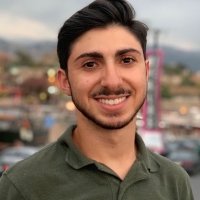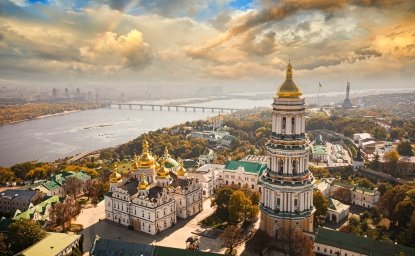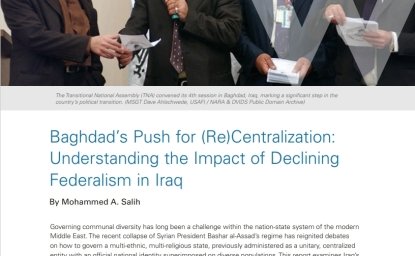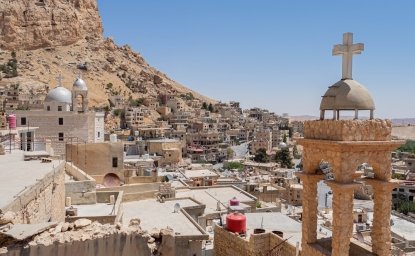Nazem is a native of the Golan Heights and has not seen his childhood home or family in 55 years. Living in Damascus, Syria, he was displaced by the 1967 war between Syria and Israel, in which the latter took control of the territory and people within it. He is from a town in the northern Golan called Ein Qiniyye, a Druze village not far from the region’s largest town of Majdal Shams. Like most Golani residents, Nazem is Druze, a small ethno-religious community that mainly live in the Levant, with a long history of autonomy and connection to their land. I interviewed Nazem over WhatsApp about his experiences, which helped me to understand the stance Golani Druze have toward their lives as Israeli subjects. In short, Golani Druze, and Druze elsewhere in Israel, have a complex relationship with the country they live in today.
Israel and the Druze
A 2020 poll reported that 61 percent of Israeli Druze individuals surveyed felt “very much” a “real Israeli”.
The Druze people in Israel have a unique relationship with the country and Jewish population. Labeled as a “Brit Damim” or Blood Covenant, the two groups share a common history of persecution leading to global diaspora networks, and their shared religious figures, Jethro and Moses, have proven a strong foundation for cooperation and coexistence. The Druze in Israel are identified as “Arabs”, however their distinct ethno-religious standing sets them apart from Muslim Arabs, and many have reached positions of authority in the Israeli government and military. According to a Pew Research Center survey, roughly 45 percent of Druze men in Israel have served in the Israeli military (Druze women are exempt), in some cases operating in the majority Druze sword battalion unit called the Herev. Israeli Druze also hold three seats (2.5 percent) in the Knesset, roughly proportional to the Druze population in Israel of 2.0 percent; their representation was as high as six seats (5.0 percent of the Knesset) in 2006 (Eilat & Shanan, 2021). Furthermore, a 2020 poll conducted by The Jewish People Policy Institute reported that 61 percent of Israeli Druze individuals surveyed felt “very much” a “real Israeli”.
Overall, these figures depict an amicable view of the Druze toward Israel. The Druze community in the Golan, however, are an exception. The vast majority still identify either as Syrian, or “undefined”, rather than Israeli. In 2011, the New York Times reported that less than 10 percent of Druze residents in the Golan held Israeli citizenship, a surprising statistic considering the territory has been subject to Israeli law since it was annexed in 1982.
Nazem belongs to this core group of Golanis who continue to challenge Israel’s occupation of the territory. Similar to the more than 120,000 Golanis who were displaced following the 1967 war, Nazem’s journey led him to Damascus, where he attended Damascus University and eventually found employment. Faced with the threat of arrest if he returned to his home in the Golan, Nazem has not been to his hometown, or seen his family since he left. Others in Nazem’s position have resorted to visiting a location along the fence outside Majdal Shams called the “Yelling Hill”, where members of separated families gather to greet one another and to shout their news. While Nazem himself has not partaken, the “Yelling Hill” has become a site that embodies the struggle that Golani Druze face being separated between two sides of a demilitarized zone.
Certain Druze have vowed to never accept Israeli citizenship. Nazem argues Israel is overseeing a “hateful occupation”, citing violations of international law and what amounted to the forced displacement of thousands of Sunnis, Palestinians, and Alawites from the Golan. Nazem and others in the Golani Druze community believe the Golan is rightfully Syrian, and Israel’s occupation, and subsequent annexation of the area, has no legal footing. “I am Syrian, and everyone in the Golan will say ‘I am Syrian.’ The truth is that we Syrians believe that we are brothers, regardless of sect or religion.” Today he and others who have fled feel their home was taken away, and had he stayed, his identity would’ve been taken too.
Life for Druze in the Golan
Golani Druze contend with myriad challenges that contribute to this negative view of Israel and a reluctance to adopt an Israeli identity, including the restrictions placed on travel between Syria and the Golan, splitting numerous families and businesses in the process. In this regard, Nazem’s story is not unique, as once the demilitarization zone was established, passage between the Golan and Syria became even more difficult and rare. Following the Yom Kippur war in 1973, the UN Disengagement Observer Force (UNDOF) was charged with overseeing the Quneitra Crossing point in the Golan between Syria and Israel. Israeli Defense Forces also maintain some presence along the crossing point, however, passage to and from the Golan must be approved because Syria is still considered an “enemy state”. Since then, this crossing has mainly been used by apple farmers in the Golan to sell their produce in Syria. In 2007 and 2010, several Druze sheikhs were indicted and convicted for crossing without permission into Syria (16 convictions were later overturned). Additionally, private travel from Syria to the Golan is all-but restricted, with only a few cases, such as Syrian brides being allowed to cross into Israel.
During 2018 mayoral elections in Majdal Shams, many individuals who planned to vote or had run for office faced scrutiny by members of the community who viewed the elections as a means of 'Israelification'.
Many Druze in the Golan benefit from a number of public programs administered by both Israel and Syria, essentially seen as incentives to identify with either state. The Syrian Government offers free higher education in Damascus for over 800 residents of the Golan, while Israel offers a number of services including universal healthcare for citizens. However, crises within the Golani Druze community run deeper than incentives can resolve, especially among those who maintain strong allegiances to Syria. When I spoke with Nazem, he explained, “In the Golan, we will remain Syrians, no matter what the temptations are,” bringing attention to the boycotts on businesses operated by those who accepted Israeli citizenship, and social ostracization like excommunication from families. This exact issue came to light during 2018 mayoral elections in Majdal Shams, in which many individuals who planned to vote, or had run for office, faced scrutiny by members of the community who viewed the elections as a means of “Israelification”.
Another issue that recently struck a chord among Druze outside of the Golan is the 2018 Jewish Nation-State Basic Law passed by the Knesset. This greatly upset Druze throughout Israel, particularly those who serve in the Israeli military and feel this law deems them as second-class citizens. These kinds of actions by Israel’s government follow a trend in which many Druze, both within Israel and throughout the Golan, feel politically abandoned. This has led to a reduction in Druze voter participation, with only 57.1 percent of Druze participating in the 2020 elections, a 14.4 percent difference from Israel’s national average of 71.5 percent, and a 6 percent difference from the 24-year average Druze voter participation of 63.1 percent. Furthermore, recent intentions to drill ground water in the Golan, and appropriation of the water away from Druze farmers in the Golan, Galilee, and Mount Carmel regions, have led to concerns over water rights for Druze throughout Israel (Mason & Dajani, 2019). These shared issues illustrate that while the Druze in Israel and the Golan have a different relationship with the Israeli state, many of their concerns, and values connected to their land are shared.
A move towards Israeli identity
Today, cultural trends demonstrate greater acceptance of Israeli identity among Golani Druze. The majority of residents are below 52 years of age and have only ever lived under Israeli rule. Majdal Shams, the region’s largest town, is filled with bars and restaurants, and many speak both Arabic and Hebrew, shaping the town into one recognizable throughout Israel. Additionally, many young Druze look to Israel and the West for education and career prospects, seeing fewer and fewer opportunities in Syria. According to the Israeli Population and Immigration Authority reporting to Pew Research, only about 11 Druze in the Golan each year between 2000 and 2014 had requested Israeli citizenship, as many Druze felt strongly tied to Syria. For those who did apply to become Israeli citizens, they were primarily driven by practical reasons, such as obtaining a passport for travel.
However, starting in 2015, Israeli citizenship requests among Golani Druze dramatically increased, with 103 requests filed that year, and 183 requests in 2016. This could be credited, in part, to the outbreak of the civil war in Syria, leaving the Golani Druze unlikely to return to a fractured state. Further, the fact that much of the current generation in the Golan have only known life under Israeli rule undoubtedly contributed to this trend, and according to various studies, younger generations of Golani Druze have a greater affinity for the socioeconomic prospects Israel can offer.
For individuals like Nazem who fled the region, the Syrian home they once knew now faces an identity crisis between which nation to call home.
Despite these growing trends towards Israeli identity, the issues outlined here remain prevalent and the sentiments toward Israeli identity continue to be a hot debate among Golani Druze families. For individuals like Nazem who fled the region, the Syrian home they once knew now faces an identity crisis between which nation to call home. Recent actions by the United States over Israel’s annexation of the Golan were met by many Druze both outside and in the region with severe contempt and seen by many as an attempt to take away their self-determination. Maintaining a policy of territorial ambiguity may be advisable in this scenario to avoid stirring tensions, not only within the Druze communities, but also internationally, as Syria recognizes the Golan as their sovereign territory.
Additionally, reassurances from the Israeli government over citizenship status in the wake of the 2018 Nation-State Basic Law, and water rights concerns for farmers, would pave the way for greater trust in the state among local Druze. Overall, it is important to recognize community-level struggles like the one facing the Golani Druze, as it determines every facet of their lives. Steps need to be taken to ensure these people feel welcome and protected, wherever they choose to call home.
The views expressed in these articles are those of the author and do not reflect an official position of the Wilson Center.
Author


Middle East Program
The Wilson Center’s Middle East Program serves as a crucial resource for the policymaking community and beyond, providing analyses and research that helps inform US foreign policymaking, stimulates public debate, and expands knowledge about issues in the wider Middle East and North Africa (MENA) region. Read more

Explore More
Browse Insights & Analysis
Who Owns Tradition? Ukraine’s Church Controversy



